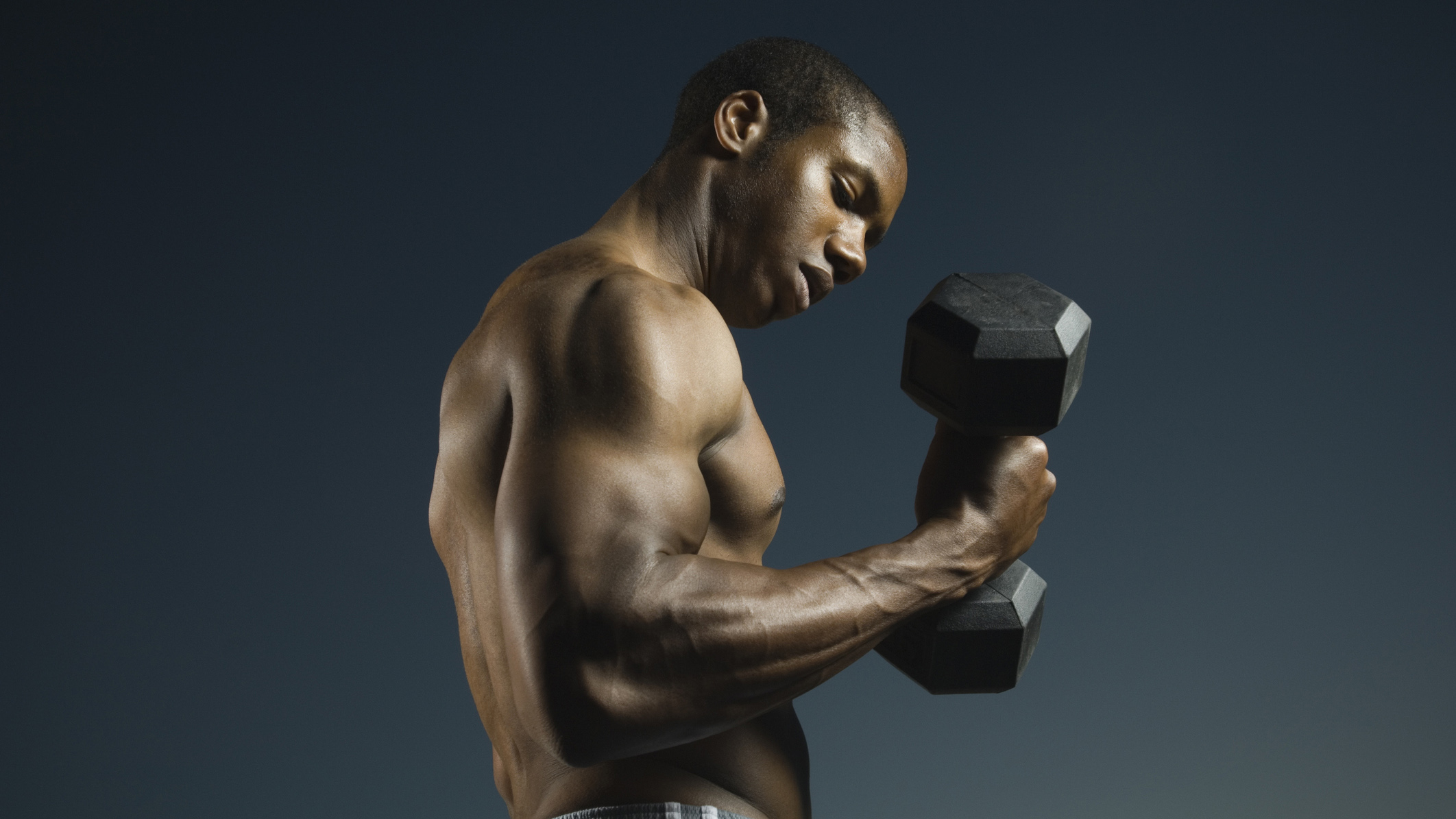

Building a pair of arms that would rival the Rock’s for thickness and general sleeve-busting brilliance is a slow and often frustrating process. The biceps, in particular, are a small and stubborn muscle group to work, yet they are incorporated into so many different exercises.
One of the most common mistakes is to over-train the biceps, because many don’t realise that they are in heavy use during pull-ups, rows and many other manoeuvres found on a typical upper body pull routine. But there's a lot more to consider, when you are seeking to get big arms.
Giving all of your muscle groups ample time to recover is paramount, but when it comes to building bigger arms, allowing the biceps plenty of opportunity to rest and repair is important, while not neglecting the triceps and other muscle groups that make up the arms is another key point you’ll find on this list.
Winter is great time to start working on building bigger arms, as it allows plenty of time to start get the workouts in before the warmer weather arrives, when we typically switch to rocking t-shirts and short sleeves.
Although it is possible to see big arm growth through bodyweight exercises (especially if you have access to a pull-up bar), some of the best kit to invest in would be a good set of dumbbells, especially those that adjust with numerous weights available, barbells and weight discs or suspension training systems, like those offered by TRX.
- I did 100 pull ups a day for a week – no, really
- A workout shoe for your routine: Under Armour TriBase Reign 2 review
- Best running headphones: also great for sweaty workouts

Curls aren't the silver bullet cure to big arms, ya know
Train hard but train safe
As previously mentioned, it’s really easy to over-train the arms, particularly the biceps, which will not only lead to a lack in development, it can also put additional pressure on the joints and tendons, potentially leading to injury.
Another common mistake among beginners looking to make gains is to massively overload the barbell or pick up stupidly heavy dumbbells and crank out curl after curl with poor form. This is pointless, because you’ll be shifting the focus to other muscle groups that likely don’t need development or worse, you could easily injure yourself.
Get all the latest news, reviews, deals and buying guides on gorgeous tech, home and active products from the T3 experts
The best advice is to start off light and work within your comfort zone, no matter what others might be doing in the gym. Someone curling 8kgs and incorporating correct techniques with perfect form is likely to see much greater improvements over the weeks than someone awkwardly hauling 20kg dumbbells around. It might look manly, but it’s just silly and counter-intuitive.
Take a look at some of the common mistake below and avoid them, focus on form and utilise the correct kit for some serious gains.
- 'Couch To 5K' in 500 words: our top 5 running tips for newbies wanting to start running
- How to lose weight fast: burn belly fat and get in shape with these 10 strategies
The 6 things you are doing wrong when building bigger arms

Don't over do it with the weight, hombre
1. Going too heavy
This is probably the most common mistake seen in gyms up and down the country: people curling heavy dumbbells with really bad form. Every time you have to swing a dumbbell to get it to the top of a curl, you’re lifting too heavy. Every time your arms flare out at the sides on the upward motion of a curl, you’re lifting too heavy. Every time you have to rush a rep, you're lifting too heavy.
Training the biceps is pretty limited to curls, because there aren’t many other movements that target them, so ensure you are performing said curl properly with strict form.
Start with a light weight and practice pinning the elbows to your sides (and slightly behind you), draw the shoulders back slightly and curl the dumbbells or barbell upwards, ensuring you take what personal trainer and owner of The Calibre Gym, Dan Best BSc, refers to as ‘the long route’.
“Rather than curling straight up to your chest, keeping the weight close to your body throughout the move, try and curl the weight slightly out in front and then upwards and inwards, keeping the elbows pinned to your sides and slightly backward but creating a nice fluid arc through the movement,” he explains.
Once mastered, it’s time to focus on speed and time under load, which brings us on to our next point…
- How to lose weight with fasting: intermittent fasting can help you lose weight fast
- Keto diet: for weight loss, Bulk Powders will tell you how to do it right

Chris Hemsworth knows the importance of keeping things slow and controlled
2. Performing the exercise way too fast
This point if perfectly applicable to bicep curls, tricep pull-downs and anything that works the deltoids (top of shoulders). Too many people rush through reps, attempting to knock out the prescribed 10 or 12 in the fastest time possible. Even if your form is great (it probably won’t be), you’re drastically reducing the time under load or time under tension (TUT), which is hugely important for working a muscle properly and thoroughly.
There’s no need to slow things down to a Hollywood-style 60fps super slow-mo, but aiming for three seconds up, a second pause at the top and three seconds during the lowering phase or a bicep curl is a good rule of thumb. For tricep pull-downs, focus on pulling the rope or handle down in a slow and controlled manner, pause and return to the top of the move using that three-second rule. Failing to do this is called…
- This push-pull, two-day exercise routine is the perfect full body workout
- Get a full body workout with just 5 simple exercises: the essentials everyone needs to know
- Get bigger pecs and arms: this two day push-pull upper body workout will get you strong in no time

The way down is just as important as the way up
3. Not controlling the negative
Many beginners think that lowering the weight back to the start position is just an annoying necessity in the workout, rather than an integral part, but that’s wrong. The eccentric phase of a bicep curl (the part where you lower the weight back down to the start position) is just as important as the concentric portion of the move.
In fact, the Journal of Sport and Health Science has proven that muscles are stronger (some believe by up to 40%) during an eccentric phase, so the ability to gradually overload the muscle during this phase offers prime potential for growth.
One example method here is to cheat slightly on a slightly heavier barbell curl than you are used to, utilising a little momentum (but ensuring strict form is maintained) to power through the concentric phase and then focussing on the negative part of the exercise, lowering the barbell in a slow and controlled manner.
The same can be said for many other arm exercises, attempting to slow down the return portion of a tricep pull-down, for example, or slowing down the return of a lateral dumbbell raise will reap the same positive results.
Scott Herman goes into some nice detail in this video below…
- Add a weights bench for more concentrated bicep curls
- Garmin Fenix 6 Pro vs Apple Watch Series 5: which is the better fitness smartwatch?
- Kettlebells are one of the most versatile pieces of fitness kit going

Half reps or 'slicing' reps can be great for increasing the load on biceps
4. Not mixing up the technique
As previously mentioned, gradually overloading the biceps is a difficult thing to do, because the point where poor form and heavy weight intersects is much sooner than most people imagine. The same can be said for working the deltoids (top of the shoulders) and, to some extent, the triceps.
It’s all-too easy to move the pin farther and farther down the weight stack when performing tricep pull-downs, neglecting good form and, as result, moving the emphasis away from the muscle group in question.
"Rather than adding weights, try mixing up your techniques," explains The Calibre Gym's, Dan Best. "During a barbell bicep curl, for example, break up the reps into blocks of seven, without any rest in-between. For the first block, only lift the barbell to just above waist height, focussing on the first portion of the move and concentrating on tempo and form.
"For the next block of seven, start with the barbell at waist height and lift to the very top of the move, before slowly returning to waist height. Finally, perform a block of seven standard curls and be prepared to feel the burn," he adds.
A method like this increases the volume and number of contractions the biceps experience, while the increased time under tension makes them work any harder. Remember, if you aren’t feeling the burn in the targeted muscle group, you’re not going to see any growth.
This explanation of stubborn bicep growth from Athlean-X goes into great detail about how to use multiple techniques for visibly bigger arms...
5. Avoiding an increase in training volume
It might sound like we are completely contradicting our previous points about over-training muscles in the arms, but increasing training volume doesn’t necessarily mean training a particular muscle group more in a single week, it just means training them harder during a workout.
How many times have you stuck to the 3 sets of 10 reps rule? This is a great place to start but it’s not the finite figure that most gym-goers and fitness fanatics religiously stick to. If you’re not seeing any growth in your arms, try adding another set to your exercise and aim for more reps. Try four sets of 12, 10, 10, 8 reps, for example.
So long as form remains correct, you should always be looking to gradually overload as the weeks progress. If it’s difficult to add small weight increments, start to look at adding in additional reps or sets (increasing the training volume) to get the muscles working and not hitting the dreaded plateau that could be holding your monster arms back.
- Here are the best protein powders to increase daily intake
- Got a sweet tooth? These protein snacks are a great way of squeezing extra grams into the daily diet
- Creatine, amino acids and vitamins & minerals all play an important part in muscle growth. Here's the lowdown

6. Neglecting diet and rest
If you are not in a calorie surplus, you won’t be building much muscle. However, this doesn’t mean you can order three XL pepperoni pizzas every night, as a calorie surplus should only be about 4-8% above maintenance. For a man, that’s between 2,000 and 3,000 calories a day depending on height weight and age, while women should aim for 1,600 to 2,400 if they wish to remain the same size and weight.
So, a typical man should really be aiming for around 2,700 healthy calories a day to see an increase in muscle mass, which could mean adding an extra meal or healthy snack to the daily menu.
Protein is also extremely important in muscle growth and getting 1 gram of protein for every 2.2kgs of body weight is a good guide for muscle growth.
Similarly, getting enough good sleep and rest between workout is paramount, as over-training is only going to kill your gains. If you are perfuming intense workouts, a good guide is to allow between 48 and 72 hours before your next session.
Leon has been writing about automotive and consumer tech for longer than he cares to divulge. When he’s not testing the latest fitness wearable and action camera, he’s out in a shed fawning over his motorcycles or trying not to kill himself on a mountain bike/surfboard/other extreme thing. He's also a man who knows his tools, and he's provided much of T3's drills coverage over the years, all without injuring himself.
